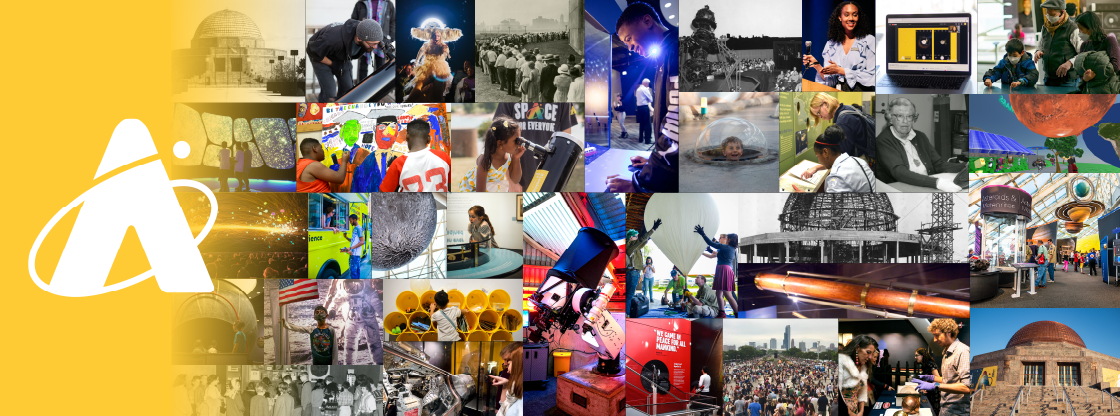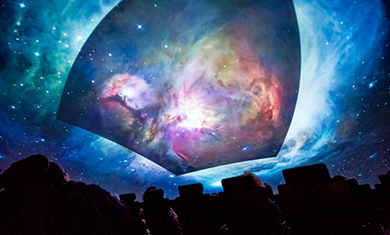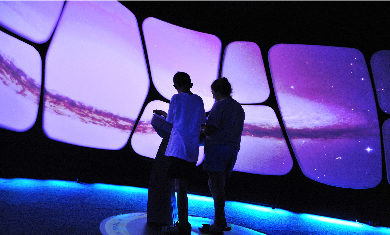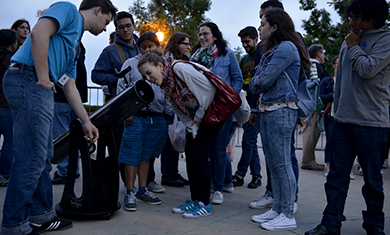History

Since opening in 1930, the Adler Planetarium connects people to the universe and each other under the sky we all share. Whether it is introducing a guest to the Ring Nebula, a neighborhood school to a community partner, or a research team to a network of citizen scientists, the Adler’s focus on meaningful connections dates back nearly a century.
Today, the Adler is bringing our unique approach—scientific exploration rooted in community and connection—to guests around the world who can enjoy the digital Adler remotely and to guests who visit the Adler in Chicago, Illinois. The museum typically hosts more than half a million visitors each year and reaches millions more through youth STEAM programs, neighborhood skywatching events, people-powered research, live digital programming, and more.
With the Adler’s support, people of all ages, backgrounds, and abilities gain the confidence to explore their universe together and return to their communities ready to think critically and creatively about any challenge that comes their way.
The Adler Planetarium Over The Years
MAY 12, 1930
The Adler Planetarium, the first planetarium in the western hemisphere, opened to the public. Chicago business leader Max Adler contributed funds for the museum’s construction, a Zeiss projector, and the Mensing Collection of astronomical instruments. South Park Commissioners agreed to assume operating costs. Adler dedicated the institution as a “classroom under the heavens” for popular astronomy education. Philip Fox was the first director of the Adler (until 1937).
1933 – 1934
During the Century of Progress World’s Fair, the Adler’s total attendance for the two-year period was more than 1.2 million people.
1935 – 1951
Annual attendance stabilized at approximately 250,000 per year from 1935 until 1942; it dropped to 177,000 and remained under 200,000 throughout World War II; attendance then returned to prewar levels until 1951. Maude Bennot was the museum’s director from 1937 to 1945, possibly the first woman in the world to lead a major science museum. Although she did the work of a director during that time—and was, after Philip Fox, arguably the most qualified person in the country to run a planetarium—the Chicago Park District never recognized Bennot as such. Her official title was “acting director” until the Park District fired her in 1945, reportedly to replace her with a man. F. Wagner Schlesinger became the Adler’s director in 1945.
MID-1950s
Robert S. Adler, son of founder Max Adler, recruited civic leaders and organized the Chicago Planetarium Society, a non-profit membership organization which promoted interest in and raised funds for the Adler.
1957
As Sputnik was launched by the USSR, attendance at the Adler increased by approximately 100,000 and continued to rise during the 1950s and 1960s, reaching 587,425 in 1967. Albert V. Schatzel served as acting director until 1960, followed by Robert I. Johnson.
1963
The Astro-Science Workshop was launched as an accelerated science course for gifted high school students. It received an early grant from the National Science Foundation.
1967
At the request of Robert S. Adler and the Chicago Planetarium Society, Mayor Richard J. Daley organized a citizen committee to study the Adler and make recommendations for its future. The committee report called for the creation of a board of trustees to share management responsibility with the Chicago Park District. The report also called for a stronger professional staff and expanded educational programming.
1968 – 1970
Joseph M. Chamberlain, EdD, then director of the Hayden Planetarium (New York), was recruited to become the Adler’s director. Following the mayor’s suggestions, he hired a professional staff and organized an evening course program. The Adler also purchased a new Zeiss planetarium projector and formed its board of trustees.
1970 – 1973
The Astro-Science Center capital campaign raised $1.8 million—matched by the Chicago Park District—to build an underground addition to the original 1930 building. The underground addition included the Kroc Universe Theater, a food service facility, school lunchroom, classrooms, library, full-scale bookstore/gift shop, and exhibition hall. These new facilities opened to the public on May 12, 1973.
1974
In January, the Adler’s first pre-recorded planetarium show, Comet Tales, premiered in the Sky Theater.
1976
The Adler’s Board of Trustees assumed full management responsibility.
1977
The Doane Observatory opened as Chicago’s first high-powered public telescope. At the same time, The Field Museum’s King Tut exhibition drew record crowds that helped increase Adler attendance to 686,085.
1980
The Adler’s 50th anniversary celebration brought attendance to its highest point since the Century of Progress World’s Fair. The Half-Century Capital Campaign raised $2.65 million for new exhibitions, automation of both the Sky Theater and the Kroc Universe Theater, renovated collection facilities, construction of the McCormick Center for Young People, Doane Observatory improvements, and installation of the Henry Moore Sundial.
1985 – 1986
The approach of Halley’s Comet increased Adler attendance by 200 percent over a six-month period.
1986
The Adler launched its Chicago’s Brightest Star campaign. By 1990, the Adler had raised $7.1 million for construction, new exhibitions, and an educational endowment.
1990
The Adler introduced Estrella de Maravilla, a Spanish-language version of its popular annual holiday sky show, Star of Wonder.
1991
The Adler “reopened” with a new exhibition area, dining, and school lunch facilities, production suite and research center, and the “Stairway to the Stars” escalator from the Kroc Universe Theater to the Sky Theater. As a result of the successful campaign, the Adler hired an education coordinator and began a teachers’ workshop program. An outreach astronomer was hired for the Adler’s first venture into off-site programming, which featured the inflatable “Starlab” portable planetarium.
Joseph M. Chamberlain retired and Paul H. Knappenberger Jr., PhD, was hired as president.
1995
The Universe In Your Hands is unveiled. The exhibition highlights instruments in the Adler’s collection that illustrate astronomers’ early theories.
1996
The Adler announced the Universe is Expanding campaign to fund a 60,000 square-foot addition, a complete renovation of the original building, and creation of new exhibition galleries.
1997
Ground was broken on the expansion project.
1999
Governor Jim Edgar opened the Sky Pavilion, along with an extensive renovation of the original 1930 building. The Adler now offered several new exhibitions and the world’s first all-digital, interactive planetarium theater.
2001
The Center for Space Science Education opened at the Adler with the help of NASA and the State of Illinois. The center included the CyberSpace Learning Center, which combined a state-of-the-art distance learning studio, multi-unit computer classroom, and an exhibition gallery offering daily updates from NASA.
2002
The Adler opened the Bringing the Heavens to Earth exhibition in the C. Paul Johnson Gallery. Visitors learned how cultures around the world explained and utilized the movement of the stars.
The Adler women’s board was launched and invited to oversee the museum’s annual black tie gala, the Celestial Ball.
2003
Aliens at the Adler kicked off a year themed around the possibilities of life on other worlds. Two new sky shows (Search for Alien Worlds and Alien Encounters) and a temporary exhibition (Stranded in an Alien Lab) invited visitors to explore the universe for other forms of life.
2004
Six new planetarium shows debuted: Mars Now!, Mars Rocks!/Future Frontier, The Future is Wild, Sonic Vision, Stars of the Pharaohs, and Secrets of Saturn.
The estate of Paul H. Leffmann announced the largest individual gift in Adler history—$5.5 million. The museum’s education center was named to recognize this generous bequest.
2005
On May 12, 2005, the Adler kicked off its 75th anniversary with a renewed commitment to academic achievement, public education, community partnerships, and museum visibility. Retired NASA astronaut Capt. James A. Lovell, Jr. served as chairman of the Adler’s 75th anniversary. The board of trustees announced a new museum vision—to inspire the next generation of explorers and become the world’s premier space science center.
2006
On November 11, the Adler unveiled the Shoot for the Moon exhibition. The first gallery—A Journey with Jim Lovell—featured Captain Lovell’s personal collection of space artifacts and the fully restored Gemini 12 spacecraft. The second gallery—Mission: Moon—showcased America’s return to the Moon in a highly interactive environment.
2007
The Boeing Company announced a $5 million commitment to help construct a new exhibition for the museum’s youngest visitors. It was the largest corporate gift in the museum’s history.
2008
The board of trustees authorized the formal naming of the museum’s History of Astronomy Department and collections as The Webster Institute for the History of Astronomy. The naming recognized the extraordinary 40-year commitment of Roderick S. and Marjorie K. Webster to the museum—as trustees, donors, and volunteer curators/collection managers. A friends group for the Webster Institute was founded to engage the philanthropic community in the Adler collection.
2009
The Grainger Foundation announced a $5 million commitment to help restore the Adler’s historic Sky Theater, the first planetarium theater in the western hemisphere.
On July 1, the Adler announced the largest fund drive in its history, the $40 million Lift-Off! Campaign for Chicago’s Space Center. It was chaired by Trustees Frank M. Clark and Captain James A. Lovell, Jr.
2010
Planet Explorers—the Adler’s first major exhibition for young children (ages 3-8)—opened in the newly-named Boeing Exploration Center.
In April, the Adler hosted a national celebration of the 40th anniversary of Apollo 13. NASA leaders, veteran astronauts, and flight directors were joined by actors from Ron Howard’s Oscar-winning film. The events raised more than $900,000 for Adler education programs.
In September, the Celestial Ball surpassed the $1 million mark in gross revenues, a ten-fold increase since the women’s board was invited to host the event in 2002.
2011
In July, the Adler unveiled the newly-renovated Grainger Sky Theater—the most technologically sophisticated theater facility in the world—and the iconic Clark Family Welcome Gallery. Deep Space Adventure premiered as the first presentation in the adjoining new spaces.
In December, the Adler concluded the Lift-Off! Campaign for Chicago’s Space Center and announced it raised $54 million.
2012
In March, Adler President Paul H. Knappenberger Jr. announced he would retire at the end of the year, after 21 years of service to the institution. A panel of trustees was recruited to oversee the search for a new chief executive officer.
2013
In January, Michelle B. Larson, PhD, became the Adler’s ninth leader and first female president and chief executive officer.
2014
In May, Destination Solar System debuted as the new marquee show in the Grainger Sky Theater.
In October, the Adler unveiled a new online catalog that makes the museum’s collection available to anyone in the world with internet access.
The Adler also completed phase one of a major renovation to the Doane Observatory—the first since its opening in 1977. Facility upgrades allowed the Doane to run independently of the museum, giving scientists and the public more time with its powerful telescope.
2015
In April, the Adler celebrated the 45th anniversary of the Apollo 13 mission and re-opened Mission Moon, an interactive exhibition that tells the story of America’s first steps to the Moon, featuring artifacts from Captain Jim Lovell’s personal collection. NASA astronauts and flight directors joined Adler trustees and donors in commemorating this historical moment.
To celebrate the 85th anniversary, the Adler opened the Community Design Lab—a collaborative workspace where guests bring their curiosity, are given a design challenge, and are offered a variety of materials to bring their ideas to life. They then are encouraged to test and tweak their designs based on the outcomes
In September, the Adler launched its first science roadshow, Galaxy Ride, taking a taste of the Adler experience to seven communities from Chicago to St. Louis along Route 66.
The Adler also broke an attendance record, welcoming 539,499 visitors—22 percent more than 2014 and the most since 1993.
2016
In May, the Adler debuted a new sky show, Planet Nine, which the Chicago Tribune called, “the Adler’s best sky show yet.”
Far Horizons, the Adler’s program of high-altitude balloon missions carrying student-designed experiments into the stratosphere, celebrated its 100th flight and set a new record for number of flights in a year at 15.
In the fall, during the Kavli Fulldome Lecture Series, the Adler executed their first virtual reality pilot, sending out Google Cardboard devices all over the world to select institutions and organizations including Lurie Children’s Hospital, so that patients could experience the immersive lecture remotely via the Cardboard and smartphone.
In total, 20,000 people looked through the Doane Observatory’s telescope in 2016 (an increase of 40 percent from 2015) including visitors from 45 states and 65 countries.
Also notable was the first prize in the BSHS Great Exhibitions Competition for What is a Planet?, ’Scopes in the City becoming a top-100 finalist for the Chicago Innovation Awards, and the Adler breaking another attendance record with an increase of 5 percent over 2015.
2017
The Adler’s Year of the Eclipse kicked off with the opening of a new temporary exhibition, Chasing Eclipses, in March.
Throughout the spring and summer, Adler educators and staff were out in the community giving talks and preparing Chicago for the great solar eclipse that occurred on August 21. The Adler’s Galaxy Ride science roadshow went to towns near Carbondale, Illinois—the site of greatest duration during the total solar eclipse—to drum up excitement with hands-on science and solar eclipse glasses.
In total, the Adler distributed 250,000 safe-solar-viewing glasses to schools, public libraries, and communities across the state and facilitated over 125 educational and outreach programs to educate those who normally would not have access to our institution.
The Adler’s eclipse efforts through August 21 impacted more than 500,000 people including a record number at the Adler when 60,000 people experienced the solar eclipse together during Chicago’s Eclipse Fest.
A total of 636,008 guests explored the universe with the Adler Planetarium, bringing space science and STEM education to even more communities throughout Illinois. Attendance increased by more than 10 percent—another record year. This outcome was due in large part to the Adler’s ongoing commitment to reach more guests beyond the museum walls.
2018
As a leader in public engagement, the Adler Planetarium inspires everyone to look up with us and connect with the sky. This was evident during our Observe Mars! event where 3,000 friends gathered to see Mars together as a community and in locations across Chicagoland, as we expanded our ’Scopes in the City reach to introduce new folks to the sky above.
Other highlights of 2018 included the launch of Letters to Lovell—a letter-writing campaign asking the public to share stories of how Captain Lovell has inspired them. Letters from people across the globe expressed how his bravery and perseverance encouraged them to pursue their dreams and to face their own challenges in times of adversity. These letters were then presented to Captain Lovell in the form of the Adler’s inaugural Lifetime Achievement Award at the 2018 Celestial Ball—the most successful Celestial Ball to date.
The Adler’s student-led initiative, The Aquarius Project—created to recover meteorites from the bottom of Lake Michigan—held its first recovery missions in the summer. The project garnered local and national media coverage, won a Chicago Innovation Award, and became the subject of the Adler’s first multi-episode narrative podcast.
In 2018, the Adler’s Far Horizons high-altitude ballooning program began a new, groundbreaking light-pollution research project in tandem with the Adler Planetarium’s Youth Organization for Lights Out (Y.O.L.O.) program. The Far Horizons NITELite mission prepared to fly sensitive cameras high above Chicago to snap thousands of images to create a map of the city at night. The data gathered would complement readings being compiled from ground-level monitors. This research, driven by students and volunteers, aimed to characterize the lighting in Chicago and identify sources of light pollution. NITELite marked the first attempt to map light pollution from high-altitude balloons and was a major focus of Far Horizons programming in the 2018-2019 academic year.
2019
The Adler celebrated the 50th anniversary of humankind’s first steps on the Moon throughout the year. A new Adler original sky show, Imagine the Moon, opened in January and focused on the many ways Earth’s natural satellite has inspired human creativity, learning, and exploration throughout history. The Adler’s main interior stairwells became sites of mini-exhibitions that included art installations and inspirational quotations from the days of NASA’s Apollo 11 mission.
Partnering with local street artists and libraries, the Adler executed the Chicago Moonshot Mural project. Community members worked with artists to create “Moonshots”—achievements thought to be impossible (like landing on the Moon) but which can be realized through teamwork and determination. The July 20 Moon landing 50th-anniversary date was marked with a two-day Moon Bash, which included hands-on programs, special lectures and performances, and one-day-only theater shows. The Bash focused on the past and the future of space exploration and how everyone can be a part of it.
In April, the Adler became the first planetarium in space with the launching of its ThinSat, a nano-satellite about the size of a slice of bread, via an Antares 110 rocket. A group of scientists, engineers, and students from Chicago’s ITW David Speer Academy built a multi-band photometer designed to measure the Earth’s brightness in six colors to ride aboard the ThinSat.
Since fewer than one percent of the 4,500 stars visible to the unaided eye can be seen in light-polluted skies, the Adler’s exhibition Chicago’s Night Sky opened to encourage curious people to look up in fall 2019. It gave visitors the opportunity to discover ways to creatively connect to the night sky, using real science and research drawn from Adler programs.
Thanks to a generous anonymous grant, the Adler developed plans to replicate its hugely popular Community Design Lab in additional locations throughout the museum. The first two of the new Labs opened in late 2019: Community PlayLab, geared toward children six and under and their families and caregivers; and the Community Star Studio, a major element of the new Chicago’s Night Sky exhibition. Plans for two more Labs went into development: a mobile community space focused on using the social sciences, and a history-focused workshop.
2020
The Adler revealed a new brand identity in January. Celebrations for the museum’s 90th anniversary were put on hold indefinitely when the museum was forced to close in mid-March, but a new online exhibition—90 Years of Stellar Connections—invited Adler fans around the world to celebrate its historic milestone and explore the museum’s past and future.
All Chicago museums were closed for varying lengths of time as the entire city locked down to prevent the spread of COVID-19. The Adler produced more than 5,800 face shields for medical staff at local west- and south-side hospitals with its 3D printers. Also, the Adler’s powerful sky show servers helped model the structure of COVID-19 proteins in support of the University of Washington’s Rosetta@home project.
The Adler launched a virtual museum that included ongoing efforts—like the citizen science projects of Adler Zooniverse and a virtual version of the museum’s teen internship program—and new programs like Sky Observers Hangout, a live YouTube series that allows viewers to interact informally with Adler experts and learn how to find objects in the sky over their own neighborhoods. Another new YouTube program, Skywatch Weekly (later renamed Skywatch Wednesday), gives viewers a guided tour of the night sky as it changes throughout the year.
The Adler’s annual Celestial Ball also made its way to the virtual world. Featured guests included NASA astronaut Captain James A. Lovell, Jr., and the event’s keynote speaker, NASA engineer Dr. K. Renee Horton. The event raised more than $1.4 million and garnered nearly 60 sponsors, 750 registered guests, and 1,000 YouTube views.
In October, Wow! Signal debuted on YouTube. This one-of-a-kind sketch-comedy musical space-science show investigates topics like space travel, black holes, the Zodiac, telescopes, parallel universes, and time travel. The show’s memorable characters, original music and animation, and playful approach make the biggest questions in physics and astronomy accessible to new audiences.
The Adler also continued preparing to reopen to the public. The then-32-year-old telescope in the Doane Observatory had been removed in 2019, so that a new 24-inch telescope from PlaneWave Instruments could be installed in 2020.
2021
The Adler Planetarium remained mission-open throughout 2021, despite the physical museum being closed to the public. Staff created new online exhibitions on topics like giant telescopes, astrology, and astronomy in the Islamic World on Google Arts & Culture.
Adler Zooniverse added more than 60 new research projects and contributed more than 80 million classifications leading to 28 peer-reviewed publications and discoveries.
The Adler created its first Virtual Field Trips (VFT) program, hosted through Mozilla Hubs. VFTs allow students from across Chicago and around the world to visit the Adler grounds virtually and interact with each other in real-time, in a custom-built 3D world. The program began in April; by the end of summer, more than 2,300 students (some as far away as California and Mexico) had participated.
A small team of staff opened the Grainger Sky Theater for limited viewings of sky shows during the summer months. Additionally, the Adler offered ’Scopes at the Adler—a ticketed event for a small group of participants to observe celestial objects through the new Doane Observatory telescope, learn how telescopes work, and learn how to find bright stars and constellations in their own sky.
In September, the Adler held its second virtual Celestial Ball with special guest Space Shuttle Astronaut Joan Higginbotham, which brought in the second-highest net revenue in Celestial Ball history.
The Adler also made the best of the ongoing pandemic closure as it completed projects that could be best executed in an empty building. The Adler’s iconic domed roof, which had been in critical need of replacement for many years, was replaced. A long-planned outdoor observing park near the Doane Observatory was completed. The 20-year-old carpet in the Solarium was replaced, and the staff area was reconfigured and refreshed. With no guests in the museum, the Adler was able to host more external film productions, even landing a starring role for the Adler (alongside actress Elisabeth Moss) in the Apple TV+ series Shining Girls.
Adler staff continued their digital push and re-thought the museum’s operating model to prepare for reopening in March 2022.








